Pressure Evolution of Ultrafast Photocarrier Dynamics and Electron–Phonon Coupling in FeTe0.5Se0.5
Abstract
:1. Introduction
2. Materials and Methods
3. Results and Discussion
3.1. High-Pressure Femtosecond Spectroscopy
3.2. High-Pressure Raman Scattering Spectroscopy
3.3. Dual Evidence for the Enhancement of the Electron-Phonon Coupling Effect
4. Conclusions
Author Contributions
Funding
Institutional Review Board Statement
Informed Consent Statement
Data Availability Statement
Conflicts of Interest
Abbreviations
| DAC | Diamond anvil cell |
| EPC | Electron–phonon coupling |
| Superconducting transition temperature | |
| LO | Longitudinal optic |
| LA | Longitudinal acoustic |
References
- Hsu, F.C.; Luo, J.Y.; Yeh, K.W.; Chen, T.K.; Huang, T.W.; Wu, P.M.; Lee, Y.C.; Huang, Y.L.; Chu, Y.Y.; Yan, D.C.; et al. Superconductivity in the PbO-type structure α-FeSe. Proc. Natl. Acad. Sci. USA 2008, 105, 4262–14264. [Google Scholar] [CrossRef] [PubMed] [Green Version]
- Horigane, K.; Takeshita, N.; Lee, C.H.; Hiraka, H.; Yamada, K. First investigation of pressure effects on transition from superconductive to metallic phase in FeTe0.5Se0.5. J. Phys. Soc. Jpn. 2009, 78, 063705. [Google Scholar] [CrossRef]
- Imai, T.; Ahilan, K.; Ning, F.L.; McQueen, T.M.; Cava, R.J. Why does undoped FeSe become a high-Tc superconductor under pressure? Phys. Rev. Lett. 2009, 102, 177005. [Google Scholar] [CrossRef]
- Dong, Y.Z.; Zheng, Y.F.; Duan, H.; Sun, Y.F.; Chen, Y.H. Formation of pyrite (FeS2) thin nano-films by thermal-sulfurating electrodeposition films at different temperature. Mater. Lett. 2005, 59, 2398–2402. [Google Scholar] [CrossRef]
- Hamdadou, N.; Khelil, A.; Morsli, M.; Bernàdeb, J.C. Iron diselenide thin films synthesized by soft selenization of iron films. Vacuum 2005, 77, 151–156. [Google Scholar] [CrossRef]
- Ghosh, A.; Thangavel, R. Electronic structure and optical properties of iron based chalcogenide FeX2 (X = S, Se, Te). Indian J. Phys. 2017, 91, 1339–1344. [Google Scholar] [CrossRef]
- Lin, Z.; Qin, M.; Li, D.; Shen, P.P.; Zhang, L.P.; Feng, Z.P.; Sha, P.; Miao, J.; Yuan, J.; Dong, X.L. Enhancement of the lower critical field in FeSe-coated Nb structures for superconducting radio-frequency applications. Indian J. Phys. 2020, 34, 015001. [Google Scholar] [CrossRef]
- Rotter, M.; Tegel, M.; Johrendt, D. Superconductivity at 38 K in the iron arsenide (Ba1-xKx)Fe2As2. Phys. Rev. Lett. 2008, 101, 107006. [Google Scholar] [CrossRef] [Green Version]
- Zhu, X.; Han, F.; Mu, G.; Cheng, P.; Shen, B.; Zeng, B.; Wen, H.H. Transition of stoichiometric Sr2VO3FeAs to a superconducting state at 37.2 K. Phys. Rev. B 2009, 79, 220512. [Google Scholar] [CrossRef] [Green Version]
- David, W.I.F.; Harrison, W.T.A.; Gunn, J.M.F.; Moze, O.; Soper, A.K.; Day, P.; Jorgensen, J.D.; Hinks, D.G.; Beno, M.A.; Soderholm, L.; et al. Structure and crystal chemistry of the high-Tc superconductor YBa2Cu3O7-x. Nature 1987, 327, 310–312. [Google Scholar] [CrossRef]
- Armitage, N.P.; Fournier, P.; Greene, R.L. Progress and perspectives on electron-doped cuprates. Rev. Mod. Phys. 2010, 82, 2421. [Google Scholar] [CrossRef]
- Lainé, M.; Seddon, A.B. Chalcogenide glasses for acousto-optic devices. J. Non Cryst. Solids 1995, 184, 30–35. [Google Scholar] [CrossRef]
- Seddon, A.B.; Laine, M.J. Chalcogenide glasses for acousto-optic devices. II. As–Ge–Se systems. J. Non Cryst. Solids 1997, 213, 168–173. [Google Scholar] [CrossRef]
- Asobe, M.; Kanamori, T.; Kubodera, K. Applications of highly nonlinear chalcogenide glass fibers in ultrafast all-optical switches. IEEE J. Quantum Electron. 1993, 229, 2325–2333. [Google Scholar] [CrossRef]
- Sanghera, J.S.; Aggarwal, I.D. Active and passive chalcogenide glass optical fibers for IR applications: A review. J. Non Cryst. Solids 1999, 256, 6–16. [Google Scholar] [CrossRef]
- Mizuguchi, Y.; Tomioka, F.; Tsuda, S.; Yamaguchi, T.; Takano, Y. Superconductivity at 27 K in tetragonal FeSe under high pressure. Appl. Phys. Lett. 2008, 93, 152505. [Google Scholar] [CrossRef]
- Garbarino, G.; Sow, A.; Lejay, P.; Sulpice, A.; Toulemonde, P.; Mezouar, M.; Núñez-Regueiro, M. High-temperature superconductivity (Tc onset at 34 K) in the high-pressure orthorhombic phase of FeSe. Europhys. Lett. 2009, 86, 27001. [Google Scholar] [CrossRef] [Green Version]
- Gresty, N.C.; Takabayashi, Y.; Ganin, A.Y.; McDonald, M.T.; Claridge, J.B.; Giap, D.; Mizuguchi, Y.; Takano, Y.; Kagayama, T.; Ohishi, U.; et al. Structural phase transitions and superconductivity in Fe1+δTe0.57Se0.43 at ambient and elevated pressures. J. Am. Chem. Soc. 2009, 131, 16944–16952. [Google Scholar] [CrossRef]
- Shimizu, Y.; Yamada, T.; Takami, T.; Niitaka, S.; Takagi, H.; Itoh, M. Pressure-induced antiferromagnetic fluctuations in the pnictide superconductor FeTe0.5Se0.5: 125Te NMR study. J. Phys. Soc. Jpn. 2009, 78, 123709. [Google Scholar] [CrossRef]
- Zhang, C.; Yi, W.; Sun, L.; Chen, X.J.; Hemley, R.J.; Mao, H.K.; Lu, W.; Dong, X.L.; Bai, L.G.; Liu, J.; et al. Pressure-induced lattice collapse in the tetragonal phase of single-crystalline Fe1.05Te. Phys. Rev. B 2009, 80, 144519. [Google Scholar] [CrossRef]
- Klein, T.; Braithwaite, D.; Demuer, A.; Knafo, W.; Lapertot, G.; Marcenat, C.; Rodière, P.; Sheikin, I.; Strobel, P.; Sulpice, A.; et al. Thermodynamic phase diagram of Fe(Se0.5Te0.5) single crystals in fields up to 28 tesla. Phys. Rev. B 2010, 82, 184506. [Google Scholar] [CrossRef] [Green Version]
- Tamai, A.; Ganin, A.Y.; Rozbicki, E.; Bacsa, J.; Meevasana, W.; King, P.D.C.; Caffio, M.; Schaub, R.; Margadonna, S.; Prassides, K.; et al. Strong electron correlations in the normal state of the iron-based FeSe0.42Te0.58 superconductor observed by angle-resolved photoemission spectroscopy. Phys. Rev. Lett. 2010, 104, 097002. [Google Scholar] [CrossRef] [Green Version]
- Yang, S.; Sobota, J.A.; Leuenberger, D.; Kempe, A.F.; Lee, J.J.; Schmitt, F.T.; Li, W.; Moore, R.G.; Kirchmann, P.S.; Shen, Z.X. Thickness-dependent coherent phonon frequency in ultrathin FeSe/SrTiO3 films. Nano Lett. 2015, 15, 4150–4154. [Google Scholar] [CrossRef] [PubMed] [Green Version]
- Tian, Y.C.; Zhang, W.H.; Li, F.S.; Wu, Y.L.; Wu, Q.; Sun, F.; Zhou, G.Y.; Wang, L.L.; Ma, X.C.; Xue, Q.K.; et al. Ultrafast dynamics evidence of high temperature superconductivity in single unit cell FeSe on SrTiO3. Phys. Rev. Lett. 2016, 116, 107001. [Google Scholar] [CrossRef] [Green Version]
- Peng, X.L.; Li, Y.; Wu, X.X.; Deng, H.B.; Shi, X.; Fan, W.H.; Li, M.; Huang, Y.B.; Qian, T.; Richard, P.; et al. Observation of topological transition in high-Tc superconducting monolayer FeTe1-xSex films on SrTiO3(001). Phys. Rev. B 2019, 100, 155134. [Google Scholar] [CrossRef] [Green Version]
- Wang, F.; Lee, D.H. The electron-pairing mechanism of iron-based superconductors. Science 2011, 332, 200–204. [Google Scholar] [CrossRef] [PubMed]
- Lanzara, A.; Bogdanov, P.V.; Zhou, X.J. Evidence for ubiquitous strong electron-phonon coupling in high-temperature superconductors. Nature 2001, 412, 510–514. [Google Scholar] [CrossRef] [Green Version]
- Gerber, S.; Yang, S.L.; Zhu, D. Femtosecond electron-phonon lock-in by photoemission and x-ray free-electron laser. Science 2017, 357, 71–75. [Google Scholar] [CrossRef] [Green Version]
- Luo, C.W.; Wu, I.H.; Cheng, P.C.; Lin, J.Y.; Wu, K.H.; Uen, T.M.; Juang, J.Y.; Kobayashi, T.; Chareev, D.A.; Volkova, O.S.; et al. Quasiparticle dynamics and phonon softening in FeSe superconductors. Phys. Rev. Lett. 2012, 357, 257006. [Google Scholar] [CrossRef]
- He, S.; He, J.; Zhang, W. Phase diagram and electronic indication of high-temperature superconductivity at 65 K in single-layer FeSe films. Nat. Mater. 2013, 12, 605–610. [Google Scholar] [CrossRef]
- Margadonna, S.; Takabayashi, Y.; Ohishi, Y.; Mizuguchi, Y.; Takano, Y.; Kagayama, T.; Nakagawa, T.; Takata, M.; Prassides, K. Pressure evolution of the low-temperature crystal structure and bonding of the superconductor FeSe (Tc = 37 K). Phys. Rev. B 2009, 80, 064506. [Google Scholar] [CrossRef] [Green Version]
- Mandal, S.; Cohen, R.E.; Haule, K. Strong pressure-dependent electron-phonon coupling in FeSe. Phys. Rev. B 2014, 89, 220502. [Google Scholar] [CrossRef] [Green Version]
- Masaki, S.; Kotegawa, H.; Hara, Y.; Tou, H.; Murata, K.; Mizuguchi, Y.; Takano, Y. Precise pressure dependence of the superconducting transition temperature of FeSe: Resistivity and 77Se-NMR study. J. Phys. Soc. Jpn. 2009, 78, 063704. [Google Scholar] [CrossRef] [Green Version]
- Wang, Z.J.; Zhang, P.; Xu, G.; Zeng, L.K.; Miao, H.; Xu, X.Y.; Qian, T.; Weng, H.M.; Richard, P.; Fedorov, A.V.; et al. Topological nature of the FeSe0.5Te0.5 superconductor. Phys. Rev. B 2015, 92, 115119. [Google Scholar] [CrossRef] [Green Version]
- Zhang, P.; Yaji, K.; Hashimoto, T.; Ota, Y.; Kondo, T.; Okazaki, K.; Wang, Z.J.; Wen, J.S.; Gu, G.D.; Ding, H.; et al. Observation of topological superconductivity on the surface of an iron-based superconductor. Science 2018, 360, 182. [Google Scholar] [CrossRef] [Green Version]
- Zhang, P.; Wang, Z.J.; Wu, X.X.; Yaji, K.; Ishida, Y.; Kohama, Y.; Dai, G.Y.; Sun, Y.; Bareille, C.; Kuroda, K.; et al. Multiple topological states in iron-based superconductors. Nat. Phys. 2019, 15, 41–47. [Google Scholar] [CrossRef] [Green Version]
- Zhang, K.; Jiang, H.; Yang, J.; Zhang, J.; Zeng, Z.; Chen, X.J.; Su, F.H. Pressure effects on the lattice vibrations and ultrafast photocarrier dynamics in 2 H–TaS2. Appl. Phys. Lett. 2020, 117, 101105. [Google Scholar] [CrossRef]
- Bhosale, J.; Ramdas, A.K.; Burger, A.; Muñoz, A.; Romero, A.H.; Cardona, M.; Lauck, R.; Kremer, R.K.; Muñoz, A.; Romero, A.H.; et al. Temperature dependence of band gaps in semiconductors: Electron-phonon interaction. Phys. Rev. B 2012, 86, 195208. [Google Scholar] [CrossRef] [Green Version]
- Karimullin, K.R.; Arzhanov, A.I.; Eremchev, I.Y.; Kulnitskiy, B.A.; Surovtsev, N.V.; Naumov, A.V. Combined photon-echo, luminescence and Raman spectroscopies of layered ensembles of colloidal quantum dots. Laser Phys. 2019, 29, 124009. [Google Scholar] [CrossRef]
- Cronin, S.B.; Yin, Y.; Walsh, A.; Capaz, R.B.; Stolyarov, A.; Tangney, P.; Cohen, M.L.; Louie, S.G.; Swan, A.K.; Ünlü, M.S.; et al. Temperature dependence of the optical transition energies of carbon nanotubes: The role of electron-phonon coupling and thermal expansion. Phys. Rev. Lett. 2006, 96, 127403. [Google Scholar] [CrossRef]
- Nakajima, H. Fabrication, properties, and applications of porous metals with directional pores. Proc. Jpn. Acad. Ser. B. 2010, 86, 884–899. [Google Scholar] [CrossRef] [Green Version]
- Ieki, E.; Nakayama, K.; Miyata, Y.; Sato, T.; Miao, H.; Xu, N.; Wang, X.-P.; Zhang, P.; Qian, T.; Richard, P.; et al. Evolution from incoherent to coherent electronic states and its implications for superconductivity in FeTe1-xSex. Phys. Rev. B 2014, 89, 140506. [Google Scholar] [CrossRef] [Green Version]
- Li, M.Y.; Huang, G.; Li, W.J.; Peng, Y.K.; Xu, G.Y.; Gu, G.D.; Chen, X.J. Transport evidence for the surface state and spin-phonon interaction in FeTe0.5Se 0.5. arXiv 2022, arXiv:2209.03267. [Google Scholar]
- Wu, Q.; Zhou, H.; Wu, Y.; Hu, L.L.; Ni, S.L.; Tian, Y.C.; Sun, F.; Zhou, F.; Dong, X.L.; Zhao, Z.X. Ultrafast quasiparticle dynamics and electron-phonon coupling in (Li0.84Fe0.16)OHFe0.98Se. Chin. Phys. Lett. 2020, 37, 1097802. [Google Scholar] [CrossRef]
- Subedi, A.; Zhang, L.; Singh, D.J.; Du, M.H. Density functional study of FeS, FeSe, and FeTe: Electronic structure, magnetism, phonons, and superconductivity. Phys. Rev. B 2008, 78, 134514. [Google Scholar] [CrossRef] [Green Version]
- Ye, Q.Q.; Liu, K.; Lu, Z.Y. Influence of spin-phonon coupling on antiferromagnetic spin fluctuations in FeSe under pressure: First-principles calculations with van der Waals corrections. Phys. Rev. B 2013, 88, 205130. [Google Scholar] [CrossRef] [Green Version]
- Wu, Y.; Yin, X.; Hasaien, J.; Ding, Y.; Zhao, Z.M. High-pressure ultrafast dynamics in Sr2IrO4: Pressure-induced phonon bottleneck effect. Chin. Phys. Lett. 2020, 7, 047801. [Google Scholar] [CrossRef]
- Um, Y.J.; Subedi, A.; Toulemonde, P.; Ganin, A.Y.; Boeri, L.; Rahlenbeck, M.; Liu, Y.; Lin, C.T.; Carlsson, S.J.E.; Sulpice, A.; et al. Anomalous dependence of c-axis polarized Fe B1g phonon mode with Fe and Se concentrations in Fe1+yTe1-xSex. Phys. Rev. B 2012, 785, 064519. [Google Scholar] [CrossRef] [Green Version]
- Camerlingo, C.; Bellingeri, E.; Nappi, C.; Sarnelli, E.; Ferdeghini, C. Raman investigation of Fe-based chalcogenide films. Phys. B 2020, 586, 411966. [Google Scholar] [CrossRef]
- Okazaki, K.; Sugai, S.; Niitaka, S.; Takagi, H. Phonon, two-magnon, and electronic Raman scattering of Fe1+yTe1-xSex. Phys. Rev. B 2011, 83, 035103. [Google Scholar] [CrossRef] [Green Version]
- Tsoi, G.; Stemshorn, A.K.; Vohra, Y.K.; Phillip, M.; Wu, F.C.; Hsu, Y.L.; Huang, M.K.; Wu, K.; Yeh, W.; Samuel, T.W. High pressure superconductivity in iron-based layered compounds studied using designer diamonds. J. Phys. Condens. Matter 2009, 21, 232201. [Google Scholar] [CrossRef] [PubMed]
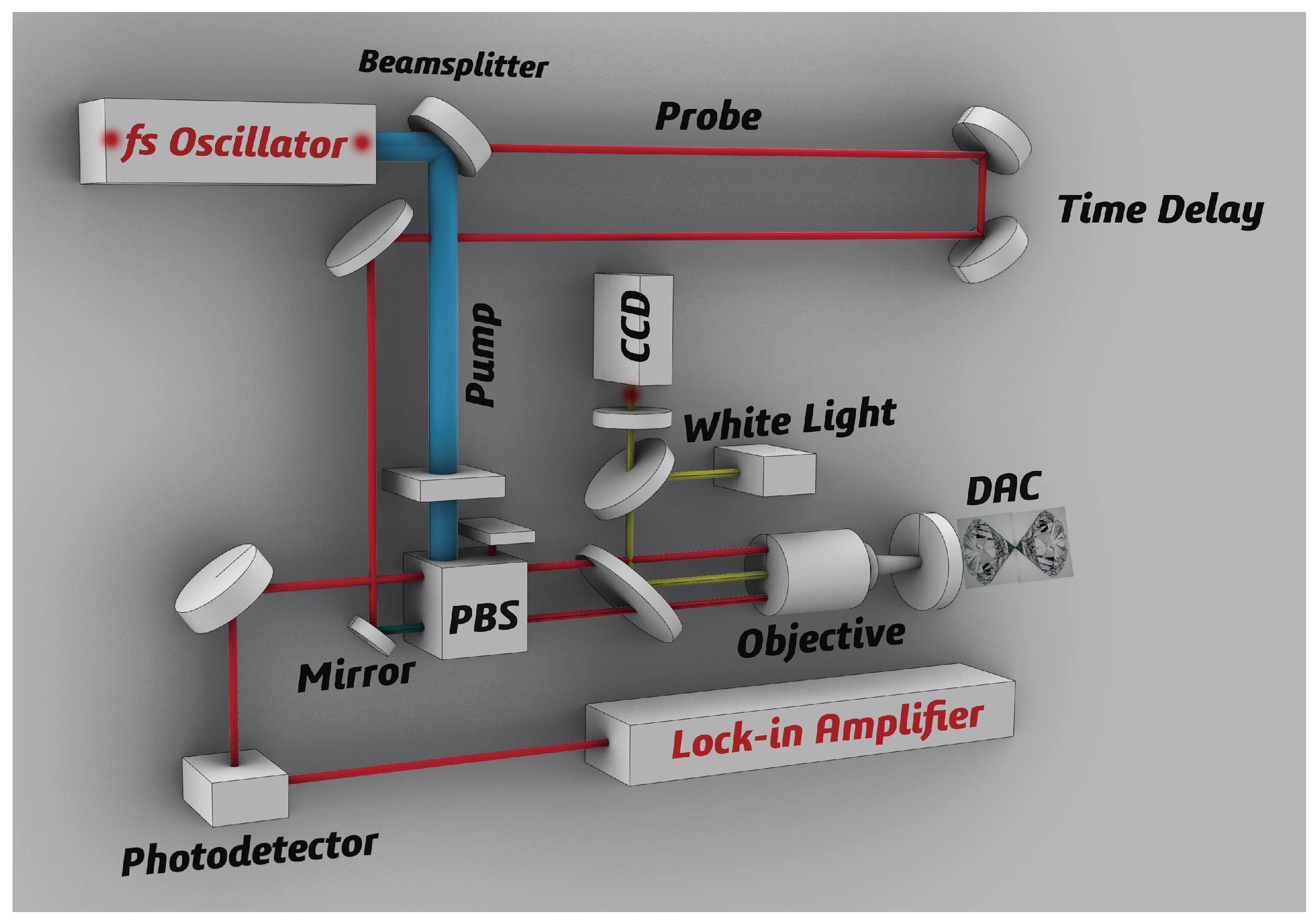
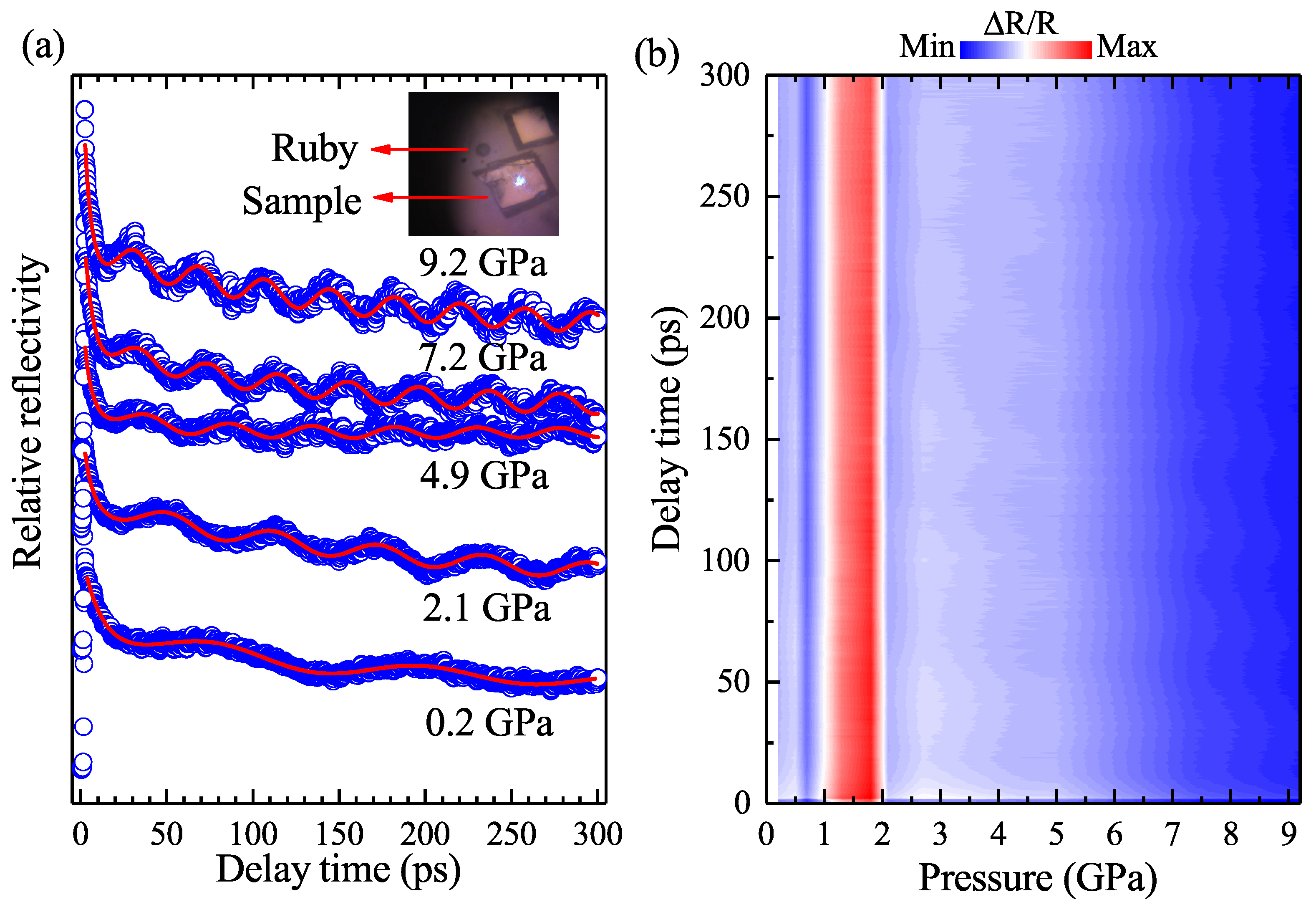
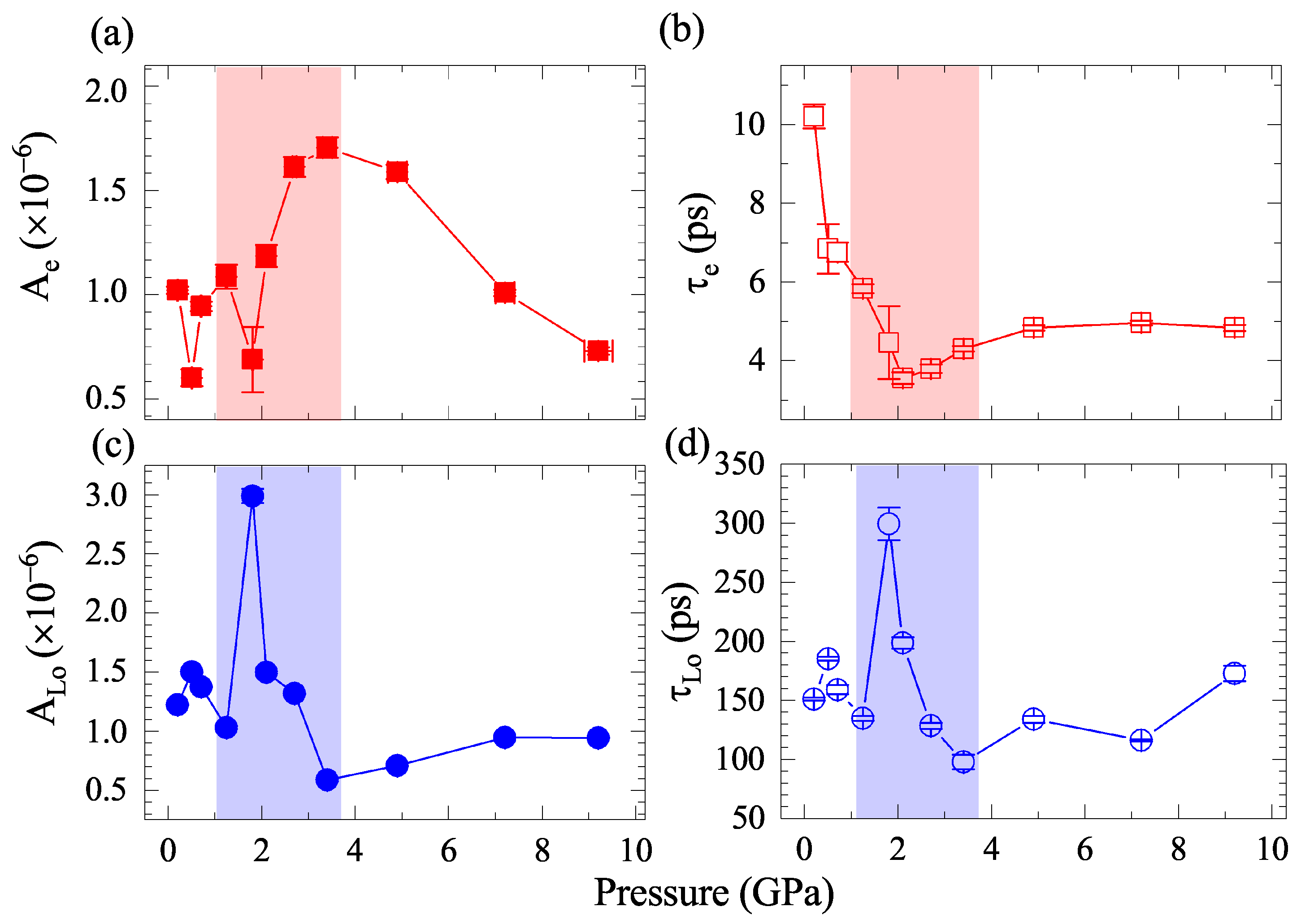
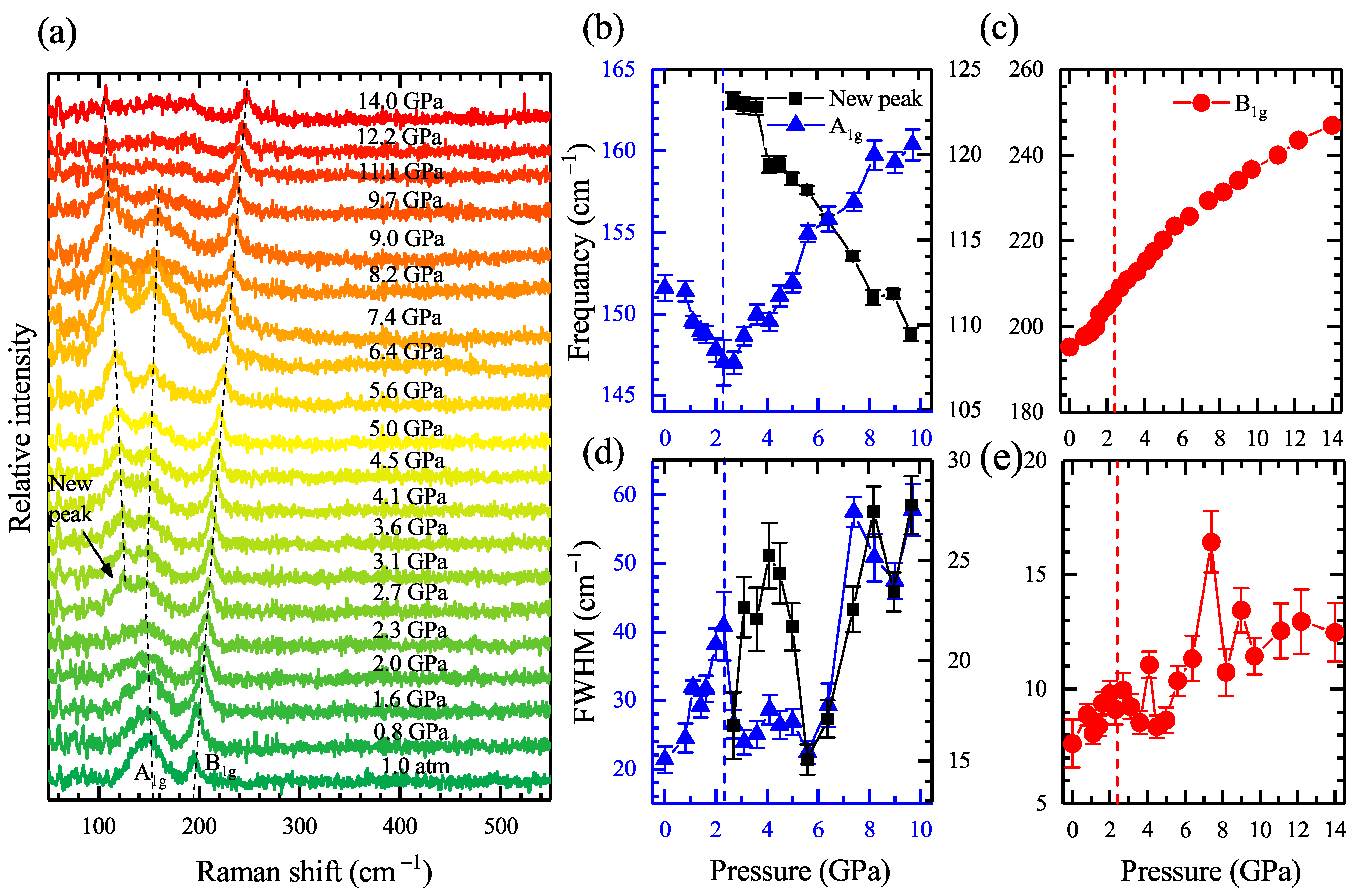
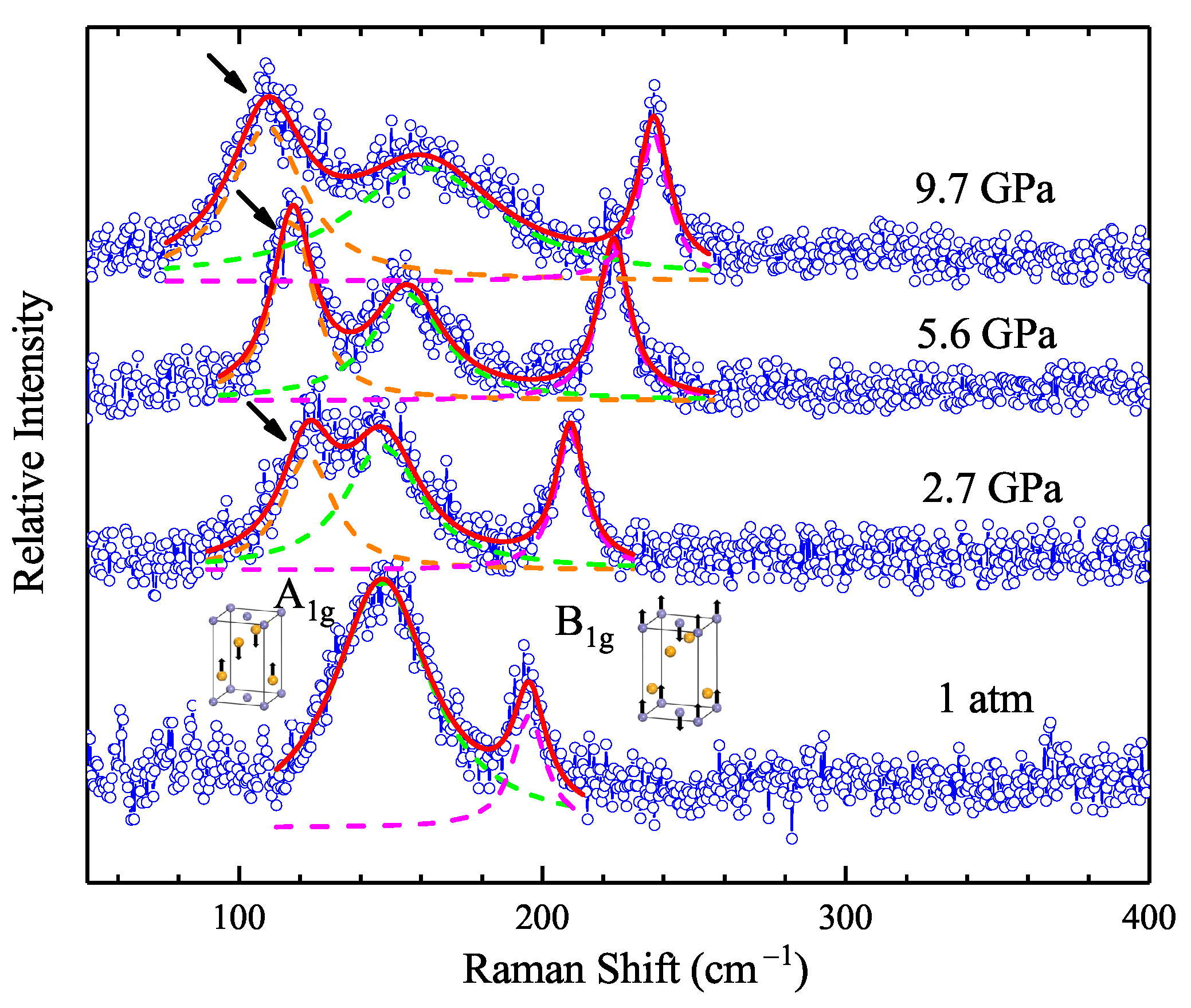
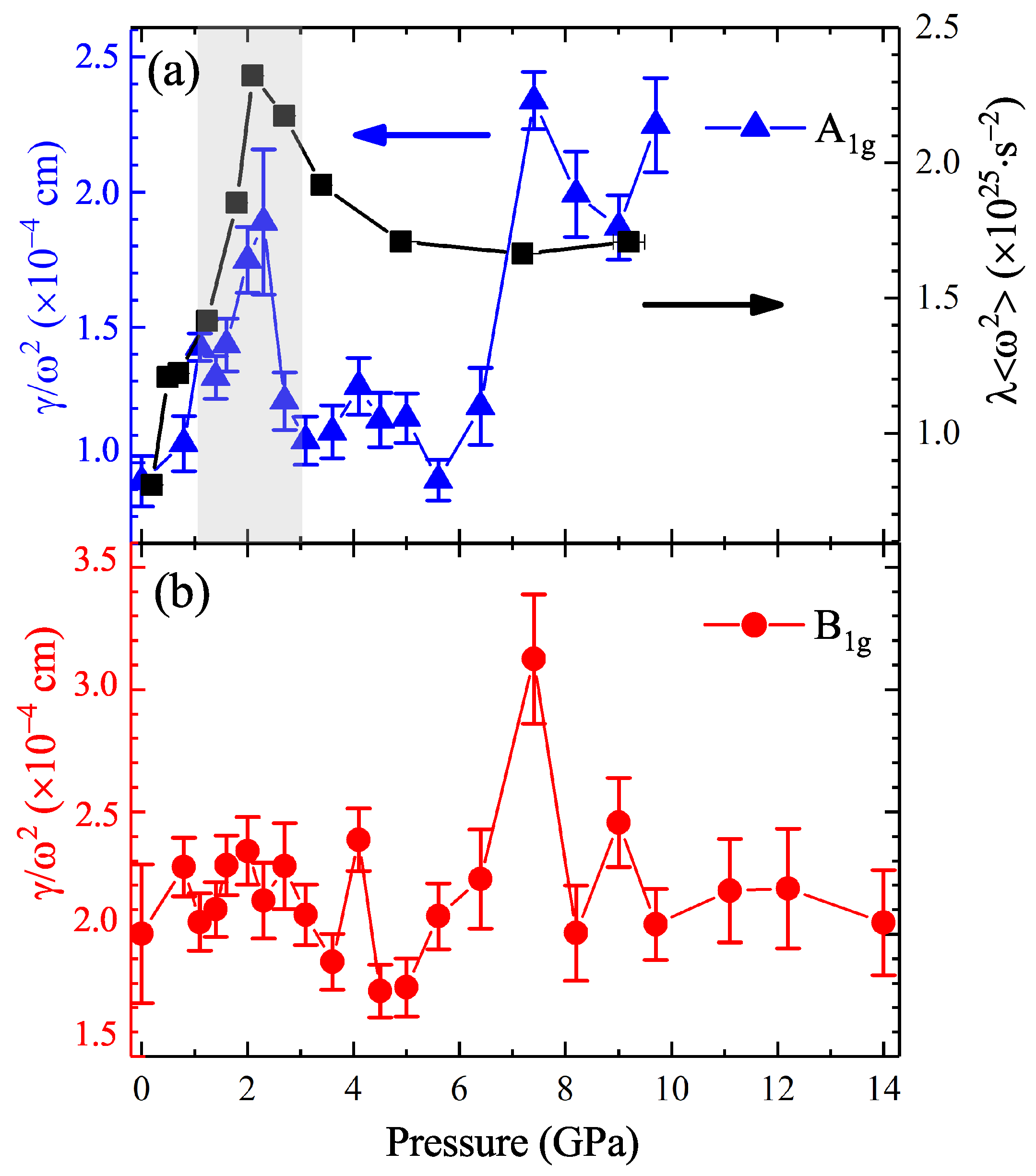
Publisher’s Note: MDPI stays neutral with regard to jurisdictional claims in published maps and institutional affiliations. |
© 2022 by the authors. Licensee MDPI, Basel, Switzerland. This article is an open access article distributed under the terms and conditions of the Creative Commons Attribution (CC BY) license (https://creativecommons.org/licenses/by/4.0/).
Share and Cite
Li, M.; Zhou, Y.; Zhang, K.; Xu, G.; Gu, G.; Su, F.; Chen, X. Pressure Evolution of Ultrafast Photocarrier Dynamics and Electron–Phonon Coupling in FeTe0.5Se0.5. Materials 2022, 15, 8467. https://doi.org/10.3390/ma15238467
Li M, Zhou Y, Zhang K, Xu G, Gu G, Su F, Chen X. Pressure Evolution of Ultrafast Photocarrier Dynamics and Electron–Phonon Coupling in FeTe0.5Se0.5. Materials. 2022; 15(23):8467. https://doi.org/10.3390/ma15238467
Chicago/Turabian StyleLi, Muyun, Yan Zhou, Kai Zhang, Guangyong Xu, Genda Gu, Fuhai Su, and Xiaojia Chen. 2022. "Pressure Evolution of Ultrafast Photocarrier Dynamics and Electron–Phonon Coupling in FeTe0.5Se0.5" Materials 15, no. 23: 8467. https://doi.org/10.3390/ma15238467



